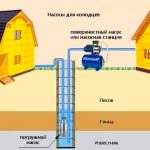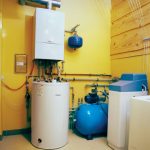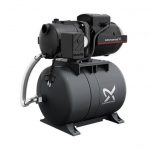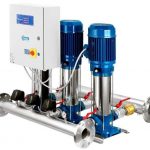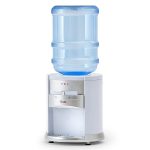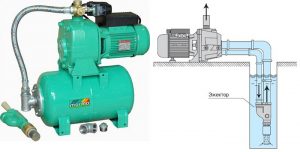 Owners of personal plots and country houses quite often encounter a common problem - the deep occurrence of groundwater. Ordinary pumping equipment located on the surface is not always able to raise water to the surface, so ejector pumping stations must be used. These devices are much more efficient and allow you to get water from depths of not more than 50 meters, and then pump it for the needs of users.
Owners of personal plots and country houses quite often encounter a common problem - the deep occurrence of groundwater. Ordinary pumping equipment located on the surface is not always able to raise water to the surface, so ejector pumping stations must be used. These devices are much more efficient and allow you to get water from depths of not more than 50 meters, and then pump it for the needs of users.
In order to find out all the technical parameters, as well as the specific nuances of the correct use of such equipment, you just need to carefully read this article, where there are answers to almost all the questions that arise when installing similar equipment.
Content
What it is
An ejector is a rather small in size, but very effective device with a simple design, so some users make it themselves. This is especially effective when the farm already has a pumping station with a powerful pump of various types. With an ejector, the equipment allows pumping clean water from a depth of 25 to 40 meters or more without much effort.
Using such additional equipment, each user saves money that would be spent on the purchase of expensive equipment. If you don’t have a similar station yet, but only a well has been dug, then immediately purchase a product equipped with an ejector.
Principle of operation
The design of the ejector consists of the following elements:
- suction chamber;
- the node where the mixing takes place;
- diffuser;
- nozzle in the narrowed part.
The last part is a pipe with a greatly narrowed end, due to this, the liquid receives additional acceleration and is discharged from the device at high speed.
According to Bernoulli’s law, such a flow exerts a small pressure on its environment, then it enters the mixer, where significant pressure is created, due to which additional volumes of water begin to flow from the suction chamber. Having united in a single flow, the liquid through the diffuser flows further into the pipeline.
In a similar design, the kinetic energy of a stream moving at a huge speed is transferred to media with a much lower speed, while new volumes of fluid are captured and transferred from the well through the pipeline to the distribution site of the water stream throughout the site. The pump station with a remote ejector is equipped with two pipes: for discharge and recirculation.
A similar design will allow the user to spend less energy, and to regulate the volume of return flows, it is necessary to install a valve in the recirculation line, which will adjust the efficiency of the entire system to the desired level. Excess water is supplied to the consumer for his needs, the amount of incoming moisture per unit time determines the performance of the entire system.
Using less power from the electric motor for the pump, the user saves energy. In addition, the ejector greatly facilitates the initial start-up of the entire system, because with a very small amount of water, it creates the necessary pressure in the pipeline and performs the first water intake, excluding idle operation of all equipment.
Varieties
Pumping stations equipped with such original devices are available in two types:
- The ejector is located inside the structure. The whole structure has a very compact size, the vacuum is created artificially, the recirculation line is located inside the product.For efficient operation, an electric motor of high power is required so that the pump runs at high speeds, creating the necessary suction force.
Advantages of this design:
- the product is less sensitive to foreign matter that may be in the water;
- however, the fluid entering for the needs of the user does not need to be additionally filtered;
- the station provides the desired pressure for all consumer needs - you can water the site and use the water inside the house at the same time.
Negative qualities:
- the equipment creates noise during operation;
- for installation, it is necessary to equip a place with sound insulation or to take the station farther from the house.
The second option does not solve all the problems, because the neighbors will complain about the noise, so sound insulation is needed in this case, plus the cost of insulation - you need to equip a standard caisson.
- The ejector is located outside the station - for this a separate tank is installed nearby, where the necessary pressure for the entire installation will be created. The ejector is connected to the pipeline going to the deep hole - there are restrictions on the diameter of the connection flange.
Pros:
- the design provides water lifting from a depth of up to 50 meters;
- significantly reduced sound exposure;
- equipment installation is located in the basement of the building;
- remoteness from the well can be up to 40 m;
- the whole structure is located in one place, therefore it is much more convenient to carry out preventive maintenance and repair, such conditions increase the designated service life of all parts.
Minuses:
- reduced performance;
- There are slight restrictions on the choice of diameter for the general pipeline.
Connection
In the case of a built-in ejector, the installation of equipment is not difficult: it is enough to connect the pipeline from the well to the suction inlet, check the hydraulic accumulator and the operation of the automation, which is charged with autonomous control of the entire system.
With an ejector outside the station, additional installation steps are added:
- we lay a recirculation line from the pressure station, and we connect the main pipe from the ejector to the pump suction pipe;
- we must connect a non-return valve to the suction of the ejector so that the liquid does not pour out by gravity when the pump stops, as well as the filter element, so that only clean water flows further.
As mentioned earlier, a valve for adjustment can be inserted in the recirculation line, and some designs already have such a device, its location and adjustment methods are indicated in the operating instructions.
Rating of the best models
Caliber SVD-770CH + E
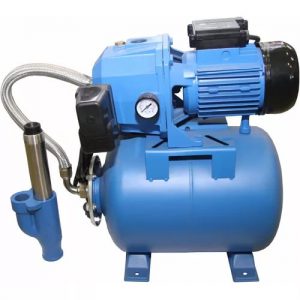
- Ejector Type: Submersible
- Suction Depth: 30 m
- Maximum head: 50 m
- Productivity: 1752 l / h
- Electric motor power: 770 W
- Design:
- hydraulic tank volume - 20 l
- outlet hole diameter - 1¼ inch (31.8 mm)
- water temperature - up to 40 ° C
- dry run protection
- Weight: 17.2 kg
- Development / Manufacturer: Russia / China
- great purchase for a summer cottage or a country house
- works at 5 plus, normal cost
- plastic thread at the connection point
The model was developed by domestic engineers, but it is produced at the PRC factories, therefore there are also some drawbacks: plastic threads on the joints will not last long - it is necessary to immediately change, and this is an additional cost.
Grundfos JPD 4-47 PT-V

- Type of ejector: cast iron with anti-corrosion coating
- Water Depth: 27 m
- Head: 47 m
- Suction speed: 3,600 l / h
- Power Consumption: 860 W
- Design:
- hydraulic tank volume - 18 l
- outlet diameter - 25.4 mm (1 inch)
- Dimensions / Weight: 327x588x416 mm / 20 kg
- Country of manufacture: Denmark
- compact size, quiet operation
- famous company makes high-quality equipment
- not found
This model is designed for private buildings, to normalize the pressure inside the home water supply with frequent drops, it copes with pumping water from deep wells.
SPERONI APM 150/25

- Ejector Type: Submersible
- Suction Depth: 40 m
- Maximum head: 49m
- Productivity: 1,500 L / h
- Electric motor power: 1.5 kW
- Design:
- hydraulic tank volume - 25 l
- centrifugal pump
- protection against overheating and dry running
- water level control automation
- Weight: 27 kg
- Country of manufacture: Speroni APM, Italy
- high-quality assembly, quiet, but very productive work
- without voltage pumps water from deep wells
- not found
The model is made of high quality materials, there is an automatic engine protection against overloads and work without water, it is used in domestic and industrial water supply systems.
Marina APM 200/25

- Ejector Type: Submersible
- Water Depth: 25 m
- Head: 45 m
- Suction speed: 3,000 l / h
- Power consumption: 1.5 kW
- Design:
- hydraulic tank volume - 25 l
- automatic water level control
- protection against work without water
- Weight: 27.7 kg
- Country of manufacture: Italy
- low energy consumption
- body and all parts made of corrosion-resistant metal
- not found
The model is designed for pumping only pure water without impurities from great depths, it works perfectly with wells with a depth of not more than 50 m.
Top Aqua AUJCB-800 ejector
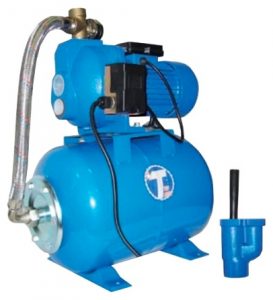
- Ejector Type: Submersible
- Suction Depth: 20 m
- Maximum head: 45 m
- Productivity: 2,400 L / h
- Electric motor power: 800 W
- Design:
- hydraulic tank volume - 24 l
- diameter of the outlet pipe - 1¼ ”
- Weight: 16 kg
- Country of manufacture: Russia
- compact size and light weight
- easy installation and easy use
- not found
The model is designed for pumping water from wells or wells no deeper than 20 m, only for clean liquid with an impurity content of not more than 50 g / cu. m
findings
Pumping stations with ejectors allow you to pump water from a fairly large depth, but at the same time you need to properly equip their location, so before buying a model, you need to make certain calculations on your site and consult with specialists. The installation of expensive equipment must be entrusted to professionals so that during operation there are no unforeseen situations that can lead to damage to individual parts.
